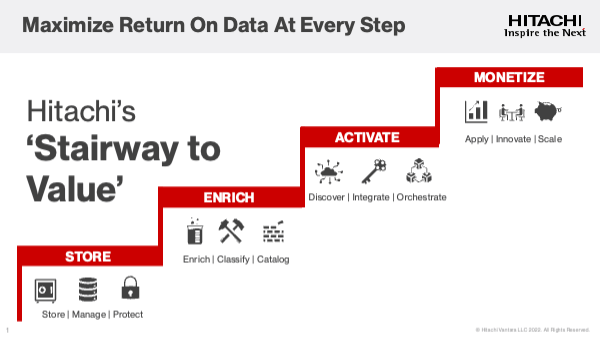Hitachi Vantara CEO Gajen Kandiah will be the first to admit it. Hitachi Vantara has struggled to get its identity across to the market. He compared the problem to the old proverb about blind men coming across an elephant. As one man grasps the trunk, he decides it is a snake. Another feels the elephant’s sides and decides he is touching a wall. Each of the men touch a different part of the elephant, and none see the big picture.
Many customers and clients have the same experience with Hitachi Vantara, not having a full picture of what it does. At a recent analyst day in Saratoga, CA, Kandiah said he often hears customers say, “I didn’t know you did that!”
If you want to know what the whole Hitachi Vantara elephant looks like, data is what holds together all of its parts. It offers data as a service from storage to turning data into insights with products, software, and consulting services. Its parent company, Hitachi, Ltd., is certainly known for its industrial strength and Hitachi Data Systems for its infrastructure products. And it is also known for its construction expertise, which gives it plenty of experience working with data on the edge in industries like mining and rail. This is how customers would often engage with Hitachi Vantara, mentioned Russell Skingsley, CTO and global VP of technical sales, starting either through infrastructure or on the edge. Then Hitachi Vantara connects the data journey in the middle with intelligent data ops, data management, and insights through their consulting services. It is a land-and-expand approach using data as the landing spot.
The Data Elephant
For most organizations, data is also like the elephant. It is siloed. According to Skingsley, 95% of it is dark, meaning no one knows it exists, what value it has, or even what is contained in the data. In other words, sales sees the “snake” and operations sees the “wall.” No part of the business sees the whole elephant. “That’s when your data lake becomes a data tar pit,” said Chief Product Officer, Radhika Krishnan. “Not only are you paying for it, but in the current regulatory environment, [dark data] is a liability to you. It could get you in trouble if it is lost personally identifiable data or data with a ‘right to be forgotten.’”
Hitachi Vantara compares the data journey to a “stairway to value” with four steps:
-
- Store: This stage is where data is stored and managed, protected, and made easier to access.
- Enrich: This stage brings all of that dark data to light. Vantara uses AI to automatically classify, tag, catalog, and index data in order to make it searchable. Data can be automatically tagged as personally identifiable or as having a “right to be forgotten.” Data can be tagged to be deleted automatically or stored to meet compliance needs.
- Activate: At this stage, data is integrated and orchestrated to make use of it. This is where analytics and AI illuminate new findings from the data
- Monetize: This is the stage where those insights are turned into actions in order to innovate and scale.

©Hitachi Vantara LLC 2022. All Rights Reserved
Customer Journeys
As mentioned, many Hitachi Vantara customer journeys start out as storage and infrastructure projects. A major railroad spoke at the event and talked about the large-scale data that Hitachi Vantara helps them manage. Hitachi Vantara has also developed a ransomware defender called Hitachi ShadowImage, which was crucial to operational security. That railroad’s director of infrastructure was only exaggerating a little when he said, “If storage goes down, trains stop. Hitachi is running the supply chain of America because it is running us.”
Another customer, an international engineering firm, does use Hitachi Vantara to analyze complex data and build services for complex outcomes through their application/data modernization and IoT consulting expertise. They set out to solve a major issue. Nearly all cities are pressed to improve and rebuild aging infrastructure. Budgets for these types of projects are limited, and the time frames can be very long.
“Some city infrastructure takes two years to design and five years to build but must operate for 25 years or more,” said the vice president and senior technology fellow of the engineering company. “How do you include a digital thread through this infrastructure to allow it to continue to be updated and improved?”
One way is to reduce the need for human inspection. City sewers are complex environments that feature miles of masonry. This masonry needs to be inspected for leaks and potential clogs or stoppages. These types of breakdowns can cause sinkholes, collapses, and long service outages. And it should come as no surprise that these environments are not the most hospitable place for human inspectors.
Cities have turned to cameras and drones to inspect the sewers. However, the footage takes hours to review by humans. It is nearly impossible for human inspectors to keep up with the amount of footage that drones can shoot.
The engineering firm turned to AI to teach computers to analyze the footage in a fraction of the time. Informed AI, the use of curated historical data augmented with domain expertise and simulations, analyzes video and prescribes solutions, making the whole process “orders of magnitude cheaper and faster.” This saved a city hundreds of millions that could be put back into more infrastructure investments.
Predictive AI is Getting Smaller
Hitachi Vantara gave two examples of predictive AI from major industrial settings that highlight the value of good data management. Both used predictive AI, sensors, IoT, and digital twins to reduce downtime in the field. This is nothing new. Predictive analytics has been used in large industrial settings for at least a decade. GE, as one example, has used AI to predict when aircraft or train engines will fail. It has long been used in nuclear plants and other utilities for the same purpose.
However, as expertise in this area grows, the use cases can get physically smaller and the industrial equipment can be cheaper, with the process still providing business value. AI is getting more accurate and applicable in more use-case situations. The speed and accuracy of analytics coupled with lower implementation costs means that return on investment is easier to achieve.
Hitachi Vantara partnered with a major theme park operator to create digital twins for its theme park rides. The data from the rides, accompanied by simulations created by Hitachi Vantara, helped predict unplanned breakdowns 48 hours in advance. Reducing downtime not only saves money but greatly increases customer satisfaction. As Skingsley said, “There is nothing more disappointing than going to a [theme] park and finding your favorite ride closed.”
A similar project involved a major trucking company. An unplanned breakdown of a truck leads to a delay of many hours. The truck must be located and replaced, often taking hours to get the repair part to the site of the breakdown. And the truck could be out of service for 36 hours or more, as technicians diagnose the problem and make repairs. Not only that, but sometimes service personnel misdiagnose a problem, leading the truck to break down again.
Hitachi Vantara used predictive AI to take sensor data from these trucks to not only predict downtime but also more accurately diagnose problems for the technician, leading to a 60% reduction in downtime for the fleet.
Connecting the Data Dots
Hitachi Vantara accomplishes all this with a growing partner ecosystem and strong hardware legacy. They asked a question in their presentation, “The future belongs to the data-driven, but why is it so hard?” Hitachi Vantara’s point of view is that it does not have to be. “We meet customers where they are in their transformation journey to deliver their business outcomes,” said Frank Antonysamy, chief digital services officer, “whether they are looking to modernize their storage, their IT systems to hybrid cloud or multicloud environments, or creating new products and solutions.” This leads to giving the customer edge and cloud flexibility, simplicity of use, and rich data insights.
As enterprises continue their data transformation journey, they are looking to make it easier. They want to automate more data discovery. They want to store data without needing a hands-on approach. Most importantly, they want to know what data they have, what it means, and how to gain value from it. Data needs to stop being a cost and become a driver of business outcomes. In other words, enterprises need to connect the dots on their data silos and see the whole picture, not just parts of it.
By Dave Wagner, Senior Research Director, Avasant





